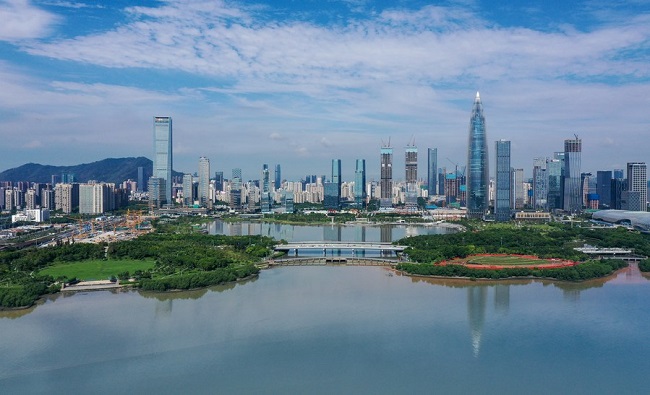'New advances' expected for economic zones

Aerial photo taken on Sept 12, 2020 shows a view of Nanshan district of Shenzhen, South China's Guangdong province. [Photo/Xinhua]
President Xi's visit to Guangdong highlights how reform, opening-up are moving forward
President Xi Jinping has used his trip to Guangdong province from Monday to Wednesday to demonstrate to the world that China will continue to forge ahead with reform and opening-up in order to build itself into a modern socialist country.
The trip took him to the cities of Chaozhou and Shantou, where he visited historical and cultural sites and enterprises, and conducted inspections on coordination of epidemic control and socioeconomic work and further reform and opening-up in the province.
Xi also attended a grand gathering in Shenzhen celebrating the 40th anniversary of the establishment of the first special economic zone in the city. During the speech delivered at the event, he urged Shenzhen, known as the test ground for China's reform and opening-up, to develop into a pilot zone for socialism with Chinese characteristics.
Xi said reform will not come to a standstill, and opening-up will only go further. "Reform and opening-up must be moved forward at a higher level, and new advances must be made in work on the fronts of special economic zones," he added.
China's decision to establish special economic zones in the southeastern coastal cities of Shenzhen, Zhuhai and Shantou in Guangdong province and Xiamen in Fujian province 40 years ago has turned out to hold the key to its reform and opening-up drive leading to the takeoff of its economy.
Shenzhen, as a trailblazer in reform and opening-up, has special significance in China's overall development. Starting from a small fishing village, it has developed into a key economic hub that has surpassed Singapore in terms of gross domestic product. In 2019, Shenzhen's GDP topped 2.69 trillion yuan ($399.6 billion). It is also a key player in the development plan of the Guangdong-Hong Kong-Macao Greater Bay Area.
It was Xi's third visit to Shenzhen since he became general secretary of the Communist Party of China Central Committee in 2012. A firm promoter of China's reform and opening-up policies, he has used every trip to the city to stress China's consistent efforts to carry forward reforms and open further to the world.
In November 2012, when Xi was elected general secretary of the CPC Central Committee, China's reforms entered an important phase.
Days after his election to the top Party post, Xi chose Guangdong as the destination of his first inspection tour, which took him to Shenzhen. During that trip, he said "reform and opening-up is a make-or-break move that decides China's destiny" and "there is no pause or backtracking".
Xi visited the city again in October 2018, when China celebrated the 40th anniversary of reform and opening-up. During that trip, he reaffirmed that reform and opening-up will never stop, and he underlined the need to explore deeper and broader areas.
He called for drawing on the experiences of Shenzhen, Zhuhai and other special economic zones, saying that their successful practices had proved that reform and opening-up is the right road.
Xi's latest trip to Shenzhen also comes at a critical time in which China is striving to build the new development pattern in response to the current domestic and international situation.
Given the global economic recession as a result of the COVID-19 pandemic and the mounting uncertainty in the international landscape, analysts said Xi's trip to Guangdong, particularly Shenzhen, is significant in drawing the blueprint for the future development of the special economic zones.
Innovative development of the special economic zones could play a bigger role in accelerating the formation of the new development pattern with the domestic market as the mainstay and the domestic and international markets complementing each other, they said.
Zheng Yougui, a researcher at the Chinese Academy of Social Sciences' Institute of Contemporary China Studies, said innovative development of the special economic zones will help the country build up new advantages in international cooperation and competition through technological innovation in order to foster emerging small and medium-sized enterprises that have a competitive edge internationally.
After decades of development, the special economic zones, which acted as the platform to introduce advanced overseas technologies and management experience 40 years ago, could become "global engines "that drive the development of advanced science and technology, and the "best windows" that showcase China's image in the new era, he said.
While helping to unleash the potential of domestic demand, they are conducive to attracting international commodities and other resources, and playing a more important role in boosting the new development pattern, he added.
China unveiled on Sunday a new comprehensive reform plan for Shenzhen to promote high-quality development of the special economic zone and build a pilot demonstration area of socialism with Chinese characteristics.
The plan, scheduled for 2020-25, gives local authorities in Shenzhen a more direct and greater say in carrying out market-based economic reform, improving market and legal environments for global businesses, building a high-level open economy, providing services for people's livelihoods, and improving the environment and urban spaces.
Chi Fulin, president of the China Institute for Reform and Development, said that as China's comprehensive reform and opening-up enters a new stage, higher-level opening-up requires institutional openness in order to abide by the trend of global development. Special economic zones could play a pioneering role in the process, he said.
Reform in Shenzhen in areas such as foreign-related commercial disputes and data rights protection will provide fresh experiences and a reference for deepening reform and opening-up nationwide, said Guo Fangda, executive vice-president of the China (Shenzhen) Development Institute.


